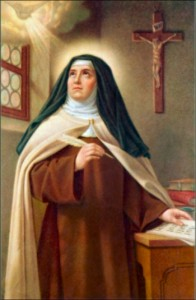Eucharistic Saints
Saint Teresa of Avila (1515-1582)
by Gary Penkala
As we continue with the National Eucharistic Revival, it would be profitable to recall those saints who had a special devotion to the Blessed Eucharist.
Over the next few articles we'll study these saints, their lives, their devotion to the Blessed Eucharist, and music connected to them.
Life
 As a leader in what might be called the Catholic Reformation (following the Protestant revolution), Saint Teresa of Avila was a staunch defender of the Faith.
A Carmelite nun, she quietly worked to restore the order's spirituality, and was persuaded by her spiritual directors to publish a great body of her writings, for which she earned the title Doctor of the Church in 1970 as decreed by Pope Saint Paul VI.
As a leader in what might be called the Catholic Reformation (following the Protestant revolution), Saint Teresa of Avila was a staunch defender of the Faith.
A Carmelite nun, she quietly worked to restore the order's spirituality, and was persuaded by her spiritual directors to publish a great body of her writings, for which she earned the title Doctor of the Church in 1970 as decreed by Pope Saint Paul VI.
A mystic, Saint Teresa was known to have had heavenly experiences, including ecstasies.
One such happening, a transverberation, was the subject of a very famous sculpture by Bernini in Chiesa di Santa Maria della Vittoria in Rome.
She is known for this beautiful prayer, Nada de turba, found in her Breviary:
Let nothing disturb you.
Let nothing make you afraid.
All things are passing.
God alone never changes.
Patience gains all things.
If you have God you will want for nothing.
God alone suffices.
Devotion to the Eucharist
In 1575, Saint Teresa described the deep secrets that God revealed to her after she had received Holy Communion:
Once after receiving Communion, I was given understanding of how the Father receives within our soul the most holy Body of Christ, and of how I know and have seen that these Divine Persons are present, and how pleasing to the Father this offering of His Son is, because He delights and rejoices with Him here – let us say – on earth.
For His humanity is not present with us in the soul, but His divinity is.
Thus the humanity is so welcome and pleasing to the Father and bestows on us so many favors.
Related Music
Ave verum from Two Three-Part Motets (Colin Brumby) —
Composer Colin Brumby has set this very useful texts for TBB voices [seminaries and scholas, note!].
The writing is wonderful — the voice parts almost sing themselves.
It is also very practical, with the range of each voice approximately within an octave:
- Tenor: G to G
- Baritone: D to B
- Bass: G to G
Ave verum sets the full text as a concise motet of 21 measures.
This motet may be performed a cappella, although an optional organ accompaniment [slightly different than the voice parts] is provided.
It can be sung by TBB or SSA voices.
O sacrum convivium (Eugene E. Englert) —
The text, O sacrum convivium, is found as the first stanza of a poem written by Saint Thomas Aquinas in honor of the Most Holy Sacrament.
Its sentiments express the profound mystery of the Eucharistic miracle: "O sacred banquet at which Christ is consumed, the memory of his Passion is recalled, our souls are filled with grace, and the pledge of future glory is given to us."
Eugene Englert, a prominent American composer living in Cincinnati, Ohio, has set the text in his own traditional and slightly chromatic style.
Beginning quietly, the motet builds with each phrase, reaching a climax on the word "gloriæ" before a series of "Alleluias" and a calm pianissimo ending.
Mr. Englert's interpretation of the Aquinas text would make a perfect communion offering by the choir, and would also be particularly appropriate for Benediction, Forty Hours and Corpus Christi.
Sicut cervus (G.P. da Palestrina / ed. Andrea Angelini) —
This setting of Sicut cervus is by many accounts the most outstanding example of religious choral art from the Renaissance.
It was written by Giovanni Pierluigi da Palestrina, often called "The Savior of Church Music," for his role in purging secular influences which had pervaded liturgical music in his time.
Prof. Andrea Angelini has taken Palestrina's exquisite music and added restrained editorial markings to promote an authentic and expressive rendition of the motet.
The SATB choral lines are consolidated into a "Rehearsal Only" keyboard score (as always with CNP), to facilitate learning.
The Latin text is taken from Psalm 42: "As the deer longs for flowing waters, so longs my soul for you, O God."
The allusion to baptism makes this motet ideal for the Easter Vigil (Psalm 42 occurs as one of the Responsorial Psalms that night) and indeed for all of Eastertide.
In a more general sense, the soul's longing for union with God can be fulfilled in the reception of the Eucharist, making Sicut cervus an excellent choice for any Communion-time meditation.
Article written 30 May 2023
|


 As a leader in what might be called the Catholic Reformation (following the Protestant revolution), Saint Teresa of Avila was a staunch defender of the Faith.
A Carmelite nun, she quietly worked to restore the order's spirituality, and was persuaded by her spiritual directors to publish a great body of her writings, for which she earned the title Doctor of the Church in 1970 as decreed by Pope Saint Paul VI.
As a leader in what might be called the Catholic Reformation (following the Protestant revolution), Saint Teresa of Avila was a staunch defender of the Faith.
A Carmelite nun, she quietly worked to restore the order's spirituality, and was persuaded by her spiritual directors to publish a great body of her writings, for which she earned the title Doctor of the Church in 1970 as decreed by Pope Saint Paul VI.